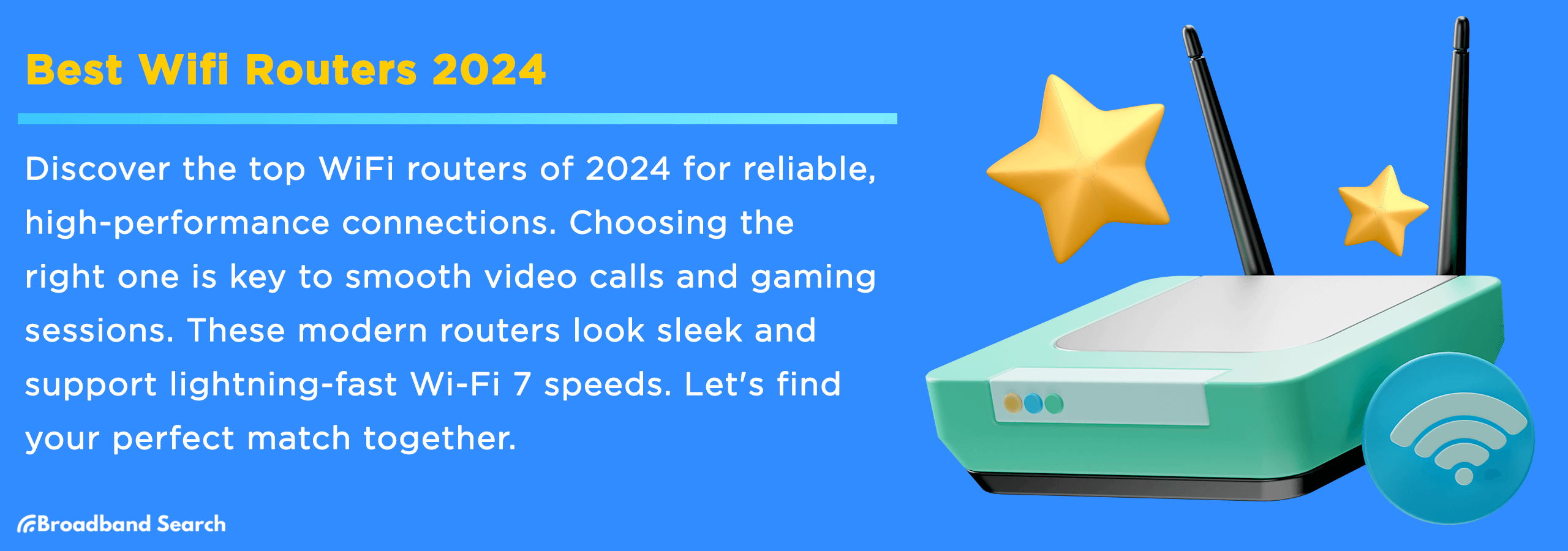Everyone knows the annoyance of video calls suddenly cutting out, online games slowing down, or downloads that seem to never end. In our hyper-connected world, choosing the right Wi-Fi router in 2024 isn't just about convenience; it's about preventing those moments of frustration and ensuring productivity.
With the rapid advancements in technology, Wi-Fi routers have come a long way from their bulky, slow predecessors. But there's more to explore. Some routers are now compatible with the blazing-fast Wi-Fi 7, which promises seamless and lightning-quick internet. In this article, we'll delve deeper into these exciting developments and help you find the perfect router for your needs.
The Transition from Wi-Fi 6E to Wi-Fi 7
Wi-Fi 6/6E, the standard familiar to many consumers, offers significant improvements in data rates, enabling faster download and upload speeds compared to its predecessors. However, on January 8, 2024, as Wi-Fi 7 was officially introduced. Building upon the foundation laid by Wi-Fi 6 and Wi-Fi 6E, Wi-Fi 7 promises even greater advancements in wireless networking technology.
Overview of Wi-Fi 6 and Wi-Fi 6E
Wi-Fi 6 (802.11ax) and Wi-Fi 6E (Wi-Fi 6 Extended) are the latest wireless networking standards, aiming to boost network performance and efficiency. Wi-Fi 6 brings several improvements, such as faster data transfer speeds, better network efficiency through advanced technologies like OFDMA and MU-MIMO, and enhanced performance in crowded areas with features like TWT and BSS Coloring.
Wi-Fi 6E extends these benefits by utilizing the newly available 6GHz frequency band, offering more channels and less interference. By 2024, Wi-Fi 6 and Wi-Fi 6E will become increasingly common in consumer and enterprise settings, with many new smartphones, laptops, and other devices equipped with these capabilities to capitalize on the enhanced performance and efficiency they provide.
Introduction to Wi-Fi 7
Wi-Fi 7, also known as 802.11be, represents the next step in wireless connectivity. It aims to make our internet experience even better by building upon the progress made with Wi-Fi 6 and Wi-Fi 6E. Wi-Fi 7 is all about speed, aiming to deliver faster data rates, less waiting time, and more reliable connections. This matters because our digital lives are becoming increasingly demanding. From streaming high-definition content to playing online games and connecting numerous smart devices, Wi-Fi 7 is designed to handle it all seamlessly.
Key Improvements of Wi-Fi 7:
Wi-Fi 7 brings significant improvements to wireless connectivity. With a wider channel bandwidth of up to 320MHz, Wi-Fi 7 can deliver faster speeds, reaching peak rates of over 40 Gbps, which is four times faster than Wi-Fi 6E.
Another enhancement is Multi-Link Operation (MLO), which introduces various multi-link options to increase throughput and reduce latency. High-Band Simultaneous Multi-Link, for instance, uses two Wi-Fi radios simultaneously in the high bands, creating a single data pipe for optimal performance, even in busy areas.
Wi-Fi 7 also introduces a new modulation scheme called 4K QAM, which boosts peak rates and increases throughput and capacity compared to older Wi-Fi systems using 1K QAM modulation.
Additionally, Wi-Fi 7 features Flexible Channel Utilization, allowing it to avoid channels with interference and utilize wider channels even in the presence of interference. This ensures better performance and reliability, particularly in challenging environments.
The Transition Period
During the transition to Wi-Fi 7, both Wi-Fi 6/6E and Wi-Fi 7 devices will be available, offering consumers choices in wireless technology. While Wi-Fi 6/6E devices will remain common, especially in existing setups, Wi-Fi 7 routers will play a crucial role in enhancing the experience of Wi-Fi 6/6E devices. Wi-Fi 7 promises faster speeds, lower latency, and better handling of multiple devices simultaneously. Wi-Fi 7 routers are already on the market, and they ensure backward compatibility with Wi-Fi 6 devices. This means you can still use a Wi-Fi 7 router with a Wi-Fi 6 device, and vice versa, to enjoy improved performance without needing to upgrade all your devices at once.
Factors to Consider When Buying a WiFi Router in 2024: Your Buyer's Guide
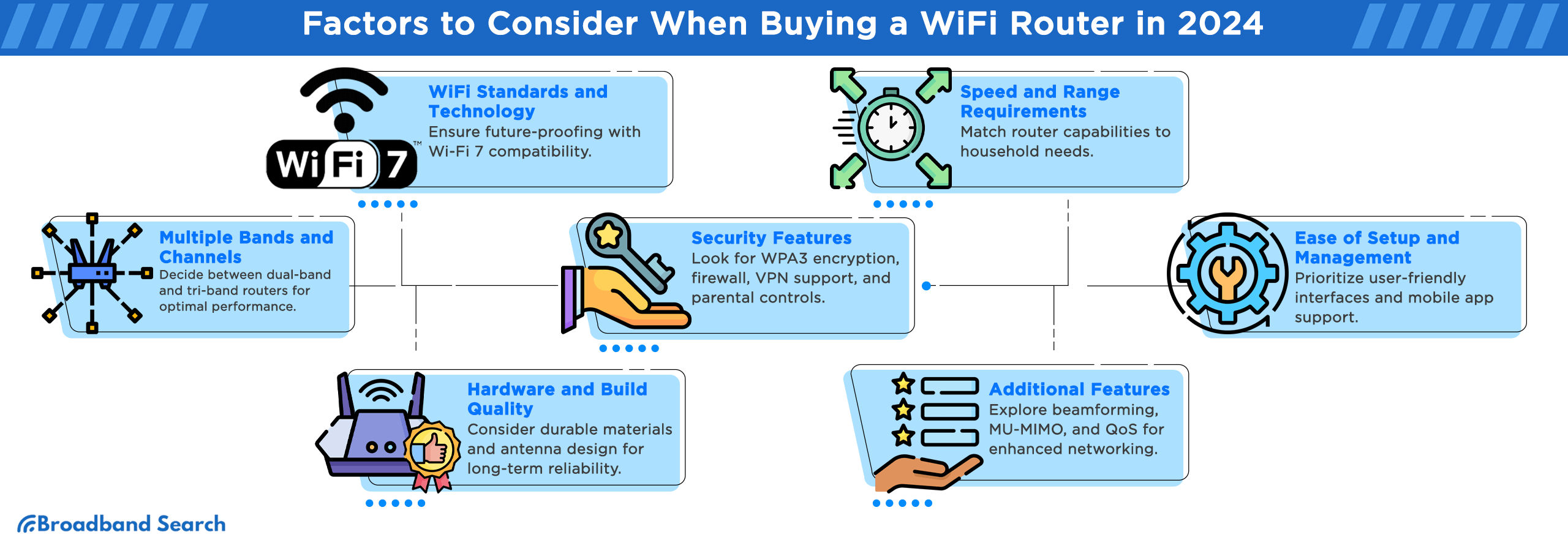
1. WiFi Standards and Technology: Future-Proofing Your Investment
When thinking about WiFi standards and technology, it's crucial to make sure you're investing in the future of your network. These standards are like the rules that your router follows when communicating with your devices. In 2024, Wi-Fi 7 finally got its official certification from the Wi-Fi Alliance after over a year of development. This makes it the latest version of the widely used wireless networking technology.
Wi-Fi 7 is backward-compatible, meaning it works with existing Wi-Fi 6 and Wi-Fi 5 devices. If you have a Wi-Fi 7 device connected to a Wi-Fi 7 access point, like a home router, you can potentially experience faster speeds and better signal reliability. So, having Wi-Fi 7 in your new router is a smart way to future-proof your network, even if not all your gadgets support it yet. It's worth checking if your current devices support Wi-Fi 7 or at least Wi-Fi 6E.
2. Speed and Range Requirements: Matching Your Router to Your Needs
When it comes to selecting the right router, it's crucial to match it to your household's specific needs. Start by considering how many devices you have and what you typically do online. Activities like gaming, streaming, and remote work can have different requirements.
To make an informed decision, it's essential to understand a few key metrics. Mbps (megabits per second) indicates the router's speed, while GHz (gigahertz) and frequency bands determine its range. Knowing these metrics can help you choose a router that suits your needs. Moreover, finding the right balance between speed and coverage is vital for a seamless online experience. Even if you have a lightning-fast router, it won't be much help if it can't reach all the corners of your home.
3. Multiple Bands and Channels: Dual-Band vs. Tri-Band Routers
When it comes to choosing between dual-band and tri-band routers, it's all about understanding their differences:
- Dual-band routers, as the name suggests, operate on two frequency bands: 2.4 GHz and 5 GHz. This dual-band capability offers flexibility, allowing you to connect various devices that might have different needs.
- On the other hand, tri-band routers go a step further by adding an extra 5 GHz band. This extra band comes in handy, especially in busy networks, as it helps reduce congestion and improves overall performance.
- Both dual-band and tri-band routers often come with a useful feature – guest networks. These guest networks allow you to provide internet access to your visitors without exposing your main network's security. So, whether you opt for dual-band or tri-band, you have the option to create a separate network for your guests, keeping your main network safe and secure.
4. Security Features: Protecting Your Digital World
Ensuring the security of your WiFi network is crucial in today's digital world, and it can be simplified into a few key considerations:
- WPA3 Encryption: Ensure your router supports the latest and most secure WPA3 encryption protocol to protect your WiFi network from unauthorized access.
- Firewall and VPN Support: Look for routers with built-in firewalls that block potential threats and VPN (Virtual Private Network) support to add an extra layer of privacy to your online activities.
- Parental Controls: Consider routers with parental control features that enable you to manage and restrict online activities, creating a safer online environment, especially for children. Parental controls on routers can be built into the router's settings, and work with third-party software or apps, while others offer cloud-based services.
5. Ease of Setup and Management: Streamlining Your Router Experience
When it comes to setting up and managing your router, it's all about keeping things simple and user-friendly.
- User-Friendly Interface: A straightforward setup and configuration process, designed to be user-friendly, even for non-tech-savvy individuals.
- Mobile App Support: Conveniently manage your router using a mobile app from your smartphone or tablet. Access features such as remote control, device prioritization, and more.
- Remote Troubleshooting Tools: Diagnose and resolve connectivity issues without requiring technical support, ensuring a smooth online experience.
6. Hardware and Build Quality: Ensuring Long-Term Reliability
When thinking about hardware and build quality, a router's materials play a vital role in its durability. Look for routers with sturdy construction, such as those made from high-quality plastic that can endure daily use. One good example is the Nest Wifi router, which incorporates 45 percent post-consumer recycled plastic, emphasizing its focus on both quality and sustainability.
Antenna design and placement also play a crucial role in the router's performance. Adjustable and strategically positioned antennas can significantly extend your WiFi coverage, ensuring a stronger signal in various areas of your home.
7. Additional Features: Enhancing Your Networking Experience
- Beamforming Technology: Focuses WiFi signals directly on connected devices, enhancing both performance and range.
- MU-MIMO (Multi-User, Multiple Input, Multiple Output) Technology: Enables your router to communicate with multiple devices simultaneously, reducing lag and improving overall connectivity.
- Quality of Service (QoS): Prioritizes internet traffic, ensuring that essential activities like video calls receive the necessary bandwidth for a seamless and uninterrupted experience.
Now that you're well-versed in the essential factors for choosing the perfect WiFi router, let's delve into the top picks for the best WiFi routers of 2024. These routers are carefully selected to meet various needs and preferences, ensuring you make an informed decision based on your specific requirements.
The Best WiFi Routers of 2024
Best Wi-Fi 7 Router Overall: Netgear Nighthawk RS700S
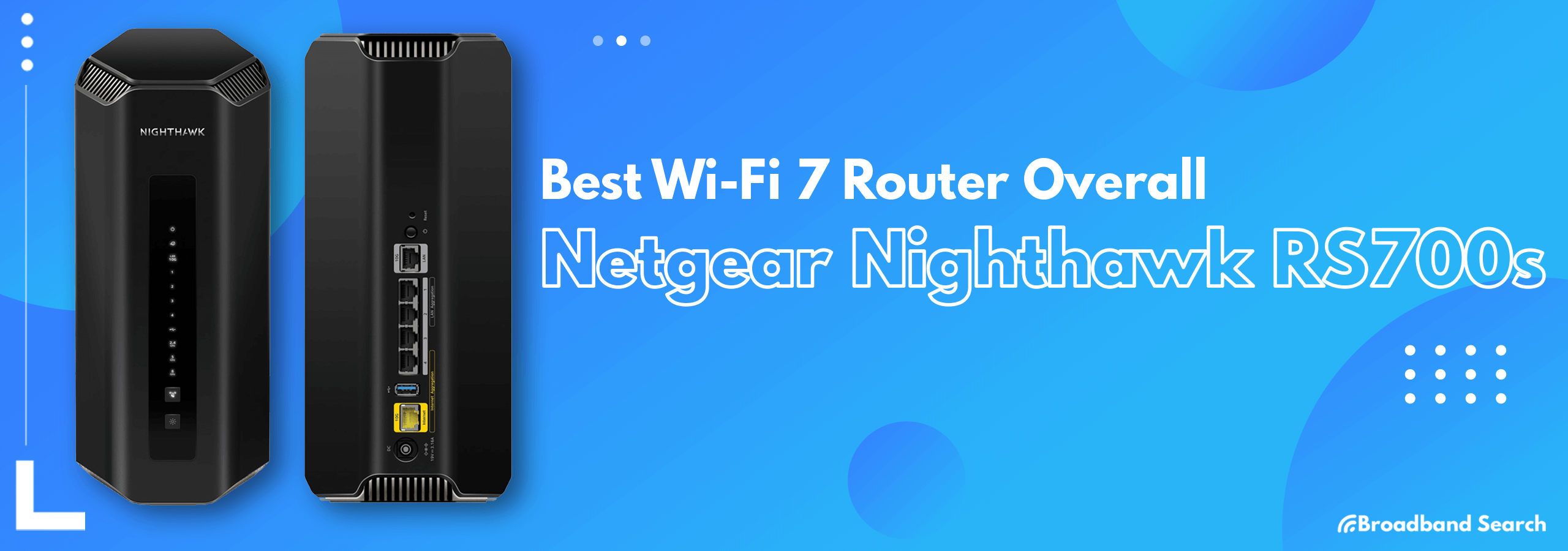
The Netgear Nighthawk RS700S is a Tri-Band router that supports the new WiFi 7 standard, which is 2.4 times faster than WiFi 6. It's fully backward compatible with older WiFi devices. The router has a sleek design and high-performance antennas, benefiting from over 25 years of NETGEAR engineering. It offers up to 3,500 sq. ft. of 360-degree WiFi coverage and features a 10 Gig internet port for blazing-fast download speeds up to 10Gbps. Additionally, it has four 1 Gig LAN ports for quick wired connections.
Key Features
- Utilizes 6GHz transmissions and 320MHz data channels.
- Offers 4X4 performance on 2.4, 5, and 6GHz bands.
- It features a 2.6GHz quad-core processor, 2GB of RAM, and 512MB of storage.
- Supports 320MHz data channels and 4K Quadrature Amplitude Modulation (QAM).
- Multi-Gig capabilities with 10Gbps Ethernet ports.
- Four gigabit per second downstream connections (two aggregatable).
- Includes a USB 3.2 port for external drive connectivity.
- 8 internal antennas optimized for multi-floor coverage and handle up to 200 devices.
Security
- NETGEAR Armor with Bitdefender Total Security (1-year subscription included)
Cost:
- Priced at $699.99 on their official site and in Amazon with an additional $100+ per year for Armor security
Coverage and Setup
- Coverage Area: Covers up to 3,500 square feet
- Easy Setup: User-friendly installation and configuration
Performance Result
The Netgear Nighthawk RS700S router performed well in various tests. It supports the 2.4, 5, and 6GHz bands, capable of handling lots of data. In a benchmark test with a OnePlus 11 phone nearby, it moved 2.278Gbps of data, slightly less than the Archer BE800. Another test showed it could deliver 3.401Gbps, slightly ahead of the Archer BE800 which is also a Triband Wi-Fi 7 router from TP-Link.
- In real-world scenarios, at 15 feet, it reached 1.773Gbps, slightly behind the Archer BE800 but still good.
- At 50 feet, it reached 691.8Mbps, beating both the Archer BE800 and Orbi RBE973. At 75 feet, it maintained its lead with 187.6Mbps, similar to the Orbi RBE973.
- At 90 feet, it achieved 40.6Mbps, making it the long-distance champion for Wi-Fi 7. However, there were still a few dead zones in a 3,500-square-foot home.
If you want to maximize your internet plan's full potential and don't mind spending a bit more, the Nighthawk RS700S is an excellent choice. Along with Wi-Fi 7 support, it delivers impressive wired speeds, perfect for high-speed internet plans. Additionally, it offers low latency, making it ideal for gamers who demand smooth performance without lag. The Nighthawk RS700S can accommodate speeds of up to 5Gbps, ensuring fast and reliable connectivity for all your needs.
Best for Gamers: ASUS ROG Rapture GT-AXE16000
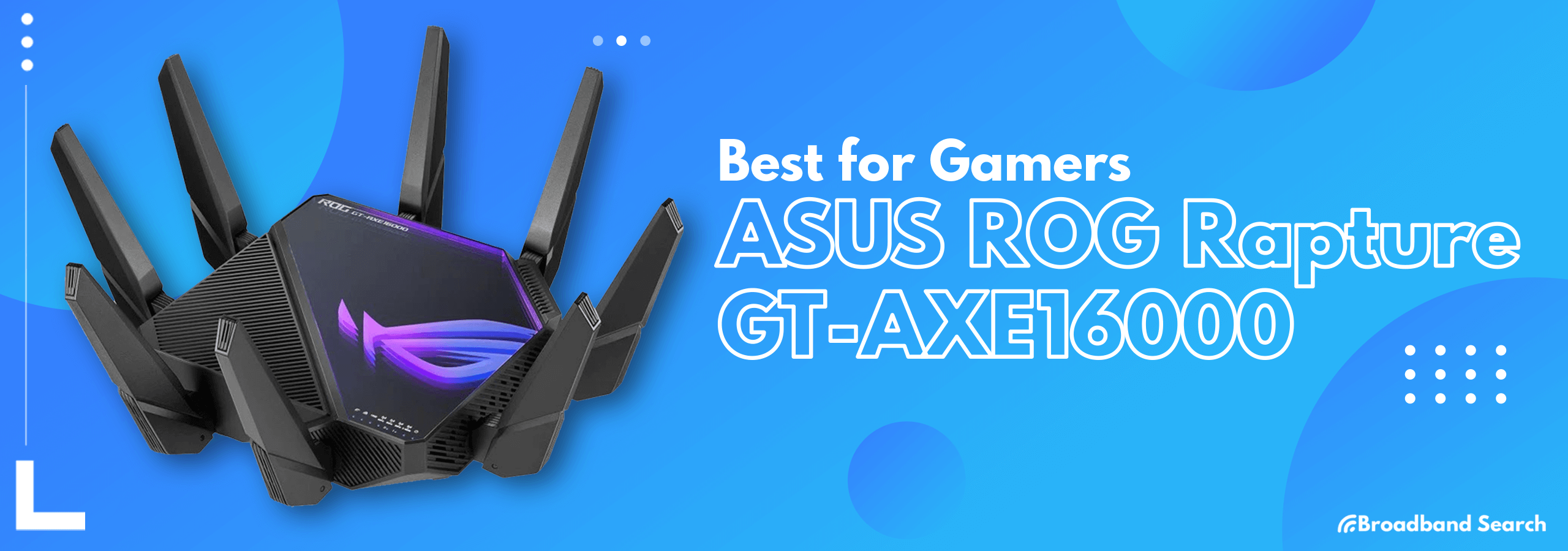
Heads up for the gamers out there! If you're looking for a router that offers a comprehensive range of features, exceptional speed, and a bold design, the Asus ROG Rapture GT-AXE16000 might be the right choice for you. Its high-speed performance, especially with 10GbE wired connections and 6GHz Wi-Fi, also ensures a smooth and fast internet experience. Moreover, its striking design and user-friendly mobile app interface add to its appeal, making it both functional and visually appealing
ASUS ROG Rapture GT-AXE16000 is designed with gamers in mind, offering unprecedented speeds of up to 16000 Mbps, ultra-low latency, and less interference. It taps into four frequency bands and features 160 MHz channels for maximum speed. A wider channel means an increased data rate. In other words, your signal can send more data per second. With Wi-Fi 6E technology, it provides stable connections with reduced congestion and increased network capacity.
Key Features
- Dual-function 10 Gbps WAN/LAN ports
- Four 1 Gbps LAN ports and a 2.5 Gbps WAN port
- Powered by a 2.0 GHz quad-core 64-bit CPU and WiFi chipsets
- ASUS RangeBoost Plus technology for enhanced coverage by up to 38%
- Triple-level game acceleration for optimized gaming experience
- ASUS AiProtection Pro with WPA3 protocol and advanced Parental Controls
- ASUS Instant Guard feature for secure public WiFi connections
Security:
- Includes ASUS AiProtection Pro with WPA3 protocol and advanced Parental Controls
- ASUS Instant Guard feature ensures secure public WiFi connections
Cost:
- Priced at $499.99 on official site and Amazon
Coverage and Setup
- Coverage: Regarding coverage, ASUS boasts improved signal range with RangeBoost Plus technology. In a test review, the router achieved speeds of 825Mbps up close and 519.3Mbps two rooms away, comparable to other mesh systems. At a distance of 25 meters, it maintained a speed of 101.5Mbps.
- Setup: The GT-AXE16000 is easy to install and manage using either a web console or mobile app. With the mobile app, users can access network details like SSID names and IP addresses and prioritize bandwidth for different apps. Installation simply involves connecting the router to the modem and following on-screen instructions.
Speed Performance Result
- Ethernet Ports: The GT-AXE16000 boasts dual 10G Ethernet ports, allowing for flexible configuration. Users can assign one as the WAN port for those with 10G Internet connections in specific regions.
- Speed Testing: In testing with 10G-capable devices, the GT-AXE16000 showcased remarkable performance. It achieved speeds of up to 9.29Gbit/s in LAN-to-LAN iPerf3 speed tests, matching the performance of dedicated 10G switches.
- Compatibility: With its impressive speed capabilities, the GT-AXE16000 serves as an ideal companion for high-end NAS servers, offering seamless integration and robust performance.
Best for Tight Budget: TP-Link Archer AX55
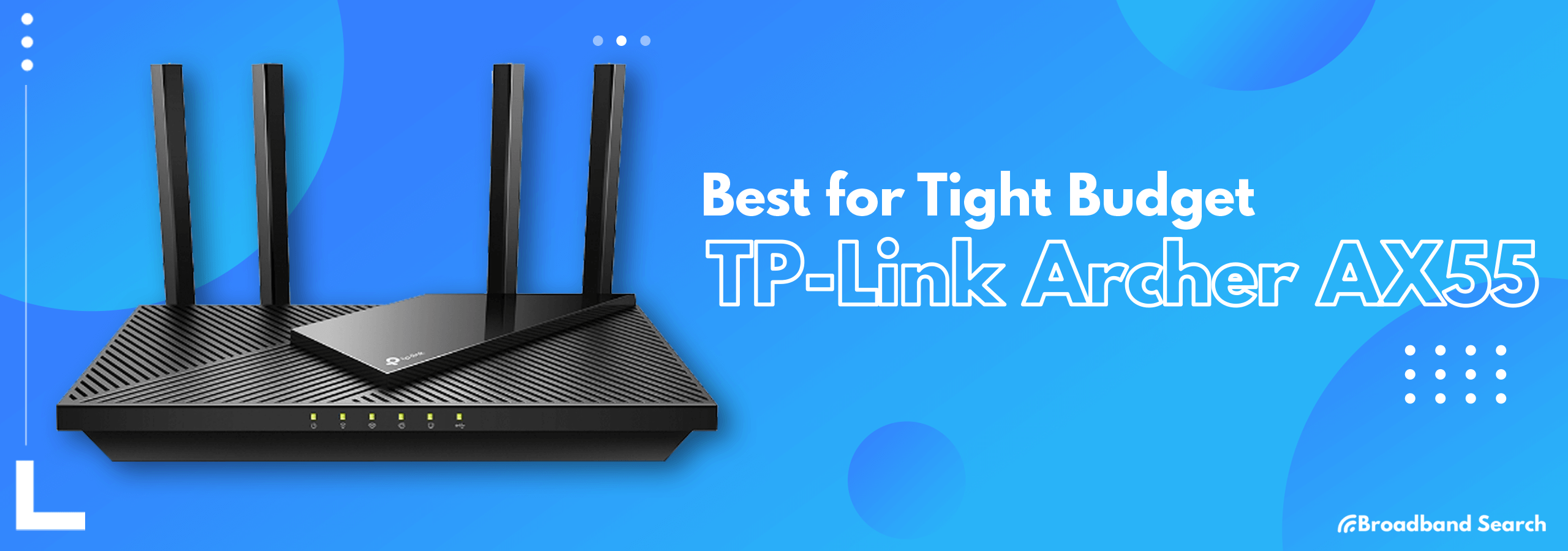
The TP-Link Archer AX55 stands out as a top pick for those on a tight budget. It offers dependable performance for everyday internet use without breaking the bank. Ideal for individuals or families in smaller to mid-sized living spaces, this router provides sufficient coverage and speed. It's particularly well-suited for households with internet speeds up to 1 Gbps and families needing robust parental controls and enhanced security features.
If you're not focused on having the latest Wi-Fi standard such as Wi-Fi 7 but rather want to boost your home internet speed affordably for daily online tasks, the Archer AX55 is an excellent fit.
Key Features
- Achieves 2402 Mbps on 5 GHz and 574 Mbps on 2.4 GHz band for smoother streaming and faster downloads.
- OFDMA technology boosts capacity by 4 times, facilitating simultaneous transmission to more devices.
- Utilizes four high-gain external antennas and Beamforming technology to extend strong, reliable Wi-Fi coverage throughout your home.
- Enables router control via voice commands, enhancing convenience with Amazon Alexa integration
Security:
- TP-Link HomeShield provides improved defense against the latest cyber threats.
Cost:
- $129.99 on the official website
Coverage and Setup
- Coverage: The Archer AX55 by TP-Link features expanded Wi-Fi coverage with four high-gain external antennas and Beamforming technology. However, it primarily relies on the 5GHz band for speed, which can lead to reduced coverage, as noted in a review by Forbes. The router's beamforming antennas enhance signal strength, but optimal placement is crucial for maximum performance.
- Setup: Whether you prefer the intuitive Tether app or TP-Link’s powerful web interface, you can set up your Archer AX55 in minutes. The Tether app allows you to manage network settings from any Android or iOS device.
Performance Result
- The Archer AX55's dual-core processor and memory ensure smooth operation, allowing it to handle multiple streams simultaneously without slowing down. In a recent test done by the NYTimes, unlike other routers with more cores, such as the Archer AX20, the Archer AX55 performs equally well, showcasing its efficiency and reliability.
While the Archer AX55 delivers excellent Wi-Fi coverage and speed on the 5 GHz bands, it may experience slower uploads on the 2.4 GHz band. However, these limitations are common among routers with Qualcomm processors. Overall, if you're seeking a budget-friendly router with solid performance and essential features, the TP-Link Archer AX55 offers excellent value.
Best for Multiple Devices and Best WI-Fi 6E Router: ASUS RT-AXE7800
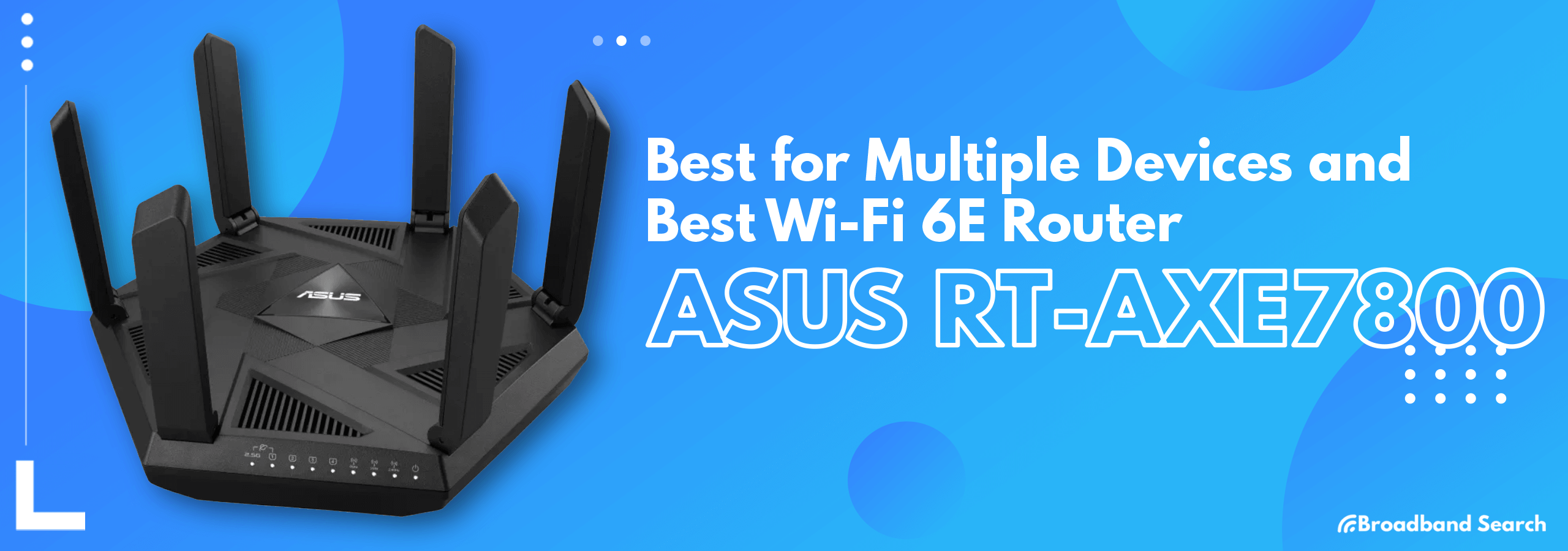
The ASUS RT-AXE7800 stands out as the top choice for users prioritizing connectivity for multiple devices and seeking the benefits of Wi-Fi 6E technology without a hefty price tag that comes with some other routers. The ASUS RT-AXE7800 provides stable connectivity with speeds of up to 7800 Mbps on Wi-Fi 6E technology, theoretically accommodating up to 100 devices.
ASUS RT-AXE7800
Key Features
- Up to 7800 Mbps on Wi-Fi 6E technology
- Theoretically supports up to 100 devices
- Quad-core up to 1.7 GHz
- With 256 MB Storage and 512 MB RAM
- Wi-Fi 6E (802.11ax) Standard and Backward Compatibility.
- Up to 2 Gbps Supported Internet Plan
- 1 x 2.5G WAN/LAN Ports
Security:
- ASUS Safe Browsing for safe internet browsing
- Enhanced Security Anywhere powered by Trend Micro™
- Free Parental Controls with flexible customizations
- Traffic optimization tools including Adaptive QoS and Traffic Analyzer
Cost:
- $279.99 on ASUS official website
Coverage: The ASUS RT-AXE7800 provides expansive coverage with AiMesh support, enabling users to extend their wireless network seamlessly using compatible routers. Equipped with six non-detachable external antennas, this router ensures reliable WiFi connectivity throughout the entire home, eliminating dead zones.
Setup: Setting up the ASUS RT-AXE7800 is straightforward with the ASUS Router mobile app. The app offers easy management and includes features like complete VPN settings, new parental control time scheduling, and visualized connection diagnostics.
Performance Result
According to a PCMag review, the RT-AXE7800 demonstrated the following performance results:
- 5GHz Close Proximity: 784Mbps
- 6GHz Band Close Proximity: 921Mbps
- 30 Feet Distance: 175Mbps
PCMag also noted that the RT-AXE7800 maintained a strong 2.4GHz signal throughout their test home, with the 5GHz signal covering the entire house but weakening slightly in the far corners of the garage.
Final Thoughts
When selecting a router from our list, remember that it's the foundation of your digital connection. Whether it's for everyday internet use, gaming, connecting a lot of devices, or if you’re looking for something that doesn’t break the bank, the right router can greatly enhance your online experience. While each router has its advantages, consider future-proofing by investing in the latest Wi-Fi technology like Wi-Fi 7. However, Wi-Fi 6E remains popular and widely used, so don't overlook its capabilities.
Focus on performance and security when making your choice. Your router is more than just hardware; it's your digital sidekick. So, choose wisely, and may your online adventures stay smooth and safe for years to come. Happy browsing!
FAQ
What is the role of a WiFi router, and why is it important?
A router is a device that sets up a local area network (LAN) in your home. It links to your modem and, in turn, connects your devices like computers, laptops, smartphones, and tablets. This router links all your devices together and enables them to communicate with each other and access the internet.
What is Wi-Fi 7, and why should I care about it in 2024?
Wi-Fi 7, IEEE 802.11be is the newest and latest IEEE 802.11 Wi-Fi standard, operating in the 6 GHz band, providing even faster speeds and reduced interference. It's crucial in 2024 because it has the potential to greatly enhance your wireless network's performance.
How do I check if my devices are compatible with Wi-Fi 6E or Wi-Fi 6?
Check your device's settings or specifications to see if it supports Wi-Fi 6 or Wi-Fi 6E. Look for these terms in your device's WiFi settings or on the manufacturer's website.
What should I consider when buying a WiFi router in 2024?
Factors to consider include WiFi standards, household speed and range needs, bands and channels, security features, ease of setup, hardware quality, and additional features.
Why is security important when choosing a WiFi router?
Security is crucial to protect your network from unauthorized access and threats. Look for routers with WPA3 encryption, firewall support, VPN capabilities, and parental controls for enhanced online security.

